
Passiflora, known also as the passion flowers or passion vines, is a genus of about 550 species of flowering plants, the type genus of the family Passifloraceae.

The Passifloraceae are a family of flowering plants, containing about 750 species classified in around 27 genera.
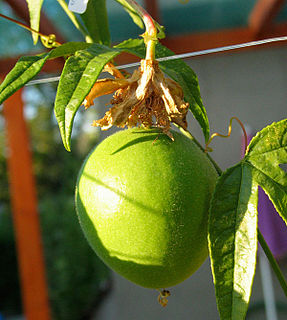
Passiflora incarnata, commonly known as maypop, purple passionflower, true passionflower, wild apricot, and wild passion vine, is a fast-growing perennial vine with climbing or trailing stems. A member of the passionflower genus Passiflora, the maypop has large, intricate flowers with prominent styles and stamens. One of the hardiest species of passionflower, it is both found as a wildflower in the southern United States and in cultivation for its fruit and striking bluish purple blooms. Passiflora incarnata fruit contain many seeds, each surrounded by an aril holding edible juice, and this juice can be consumed fresh or used to flavor processed products.
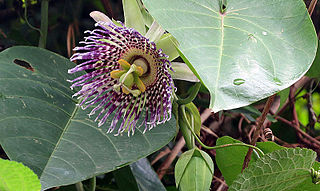
Passiflora ligularis, commonly known as the sweet granadilla or grenadia, is a plant species in the genus Passiflora. It is known as granadilla in Bolivia, Colombia, Nicaragua, Costa Rica, Ecuador, Mexico, the Azores Islands, South Africa and Peru; granadilla común in Guatemala; granadilla de China or parcha dulce in Venezuela and granaditta in Jamaica.

Passiflora alata, the winged-stem passion flower, is a species of flowering plant. It is an evergreen vine, growing to 6 m (20 ft) or more, which bears an edible type of passion fruit. It is native to the Amazon, from Peru to eastern Brazil.

Photinia serratifolia, commonly called Taiwanese photinia or Chinese photinia is a flowering shrub or tree in the flowering plants family Rosaceae, found in mixed forests of China, Taiwan, Japan, the Philippines, Indonesia, and India.

Passiflora actinia species of passion flower of the Passifloraceae. It flowers mainly in early spring, producing white, mauve and blue flowers about 9 cm wide.

Passiflora tripartita also called curuba, tumbo, curuba de Castilla and tumbo serrano is a species of Passiflora from Peru, Bolivia, Ecuador, Colombia, and Brazil in areas at elevations of 2000 – 3200 meters.

Passiflora loefgrenii, the garlic passion fruit, is a passion flower that was first formally described 1997 by Fabio Augusto Vitta. The plant is named after Albert Löfgren, the first known collector.
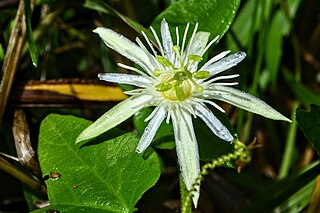
Passiflora capsularis is a member of the family Passifloraceae with vanilla scented, delicate white flowers around 5 centimetres (2.0 in) long. It produces unusual looking ribbed ellipsoid fruits reddish purple in color, which are not edible. It grows readily in tropical climates, tolerating down to 5 °C and even lower for short spells. It flowers and grows readily even in small pots.
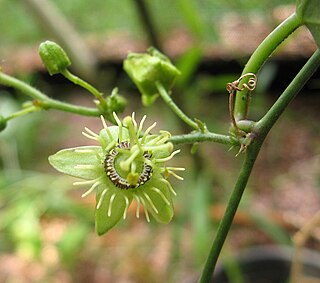
Passiflora suberosa is a species of passionflower that is native to the Americas. Its range stretches from Florida and the Lower Rio Grande Valley of Texas in the United States south through Mexico, Central America, and the Caribbean to South America. It is commonly known as corkystem passionflower due to the corkiness of older stems. The fruit is not hardy and transitions from green to indigo, purple and, lastly, black as it ripens. This species is a host plant for the caterpillars of the Gulf fritillary, Julia heliconian, Mexican silverspot, red postman, and zebra heliconian. It is a larval host plant for the glasswing butterfly in Australia.

Passiflora coccinea is a fast-growing vine. The vine is native to northern South America.

Passiflora antioquiensis, the red banana passionfruit, is a species in the family Passifloraceae. It is native to Colombia and is named for the Antioquia Department in Colombia where the type specimen was collected. It was originally described by Gustav Karl Wilhelm Hermann Karsten in 1859.

Passiflora arbelaezii is a species in the family Passifloraceae native to eastern Nicaragua and western Colombia. This species was named in honor of Enrique Pérez Arbeláez, the person who collected the type specimen. It was first formally described in 1957 by Antonio Lorenzo Uribe Uribe.
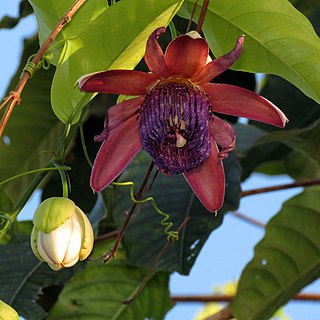
Passiflora ambigua is a species of Passiflora from Belize, Costa Rica, and Colombia.

Passiflora cinnabarina is a species of Passiflora from Australia.

Passiflora cincinnata is a species of Passiflora from Brazil.

Passiflora membranacea is a species of Passiflora from Costa Rica, Guatemala, and El Salvador.

Passiflora manicata is a species of Passiflora from Colombia and Ecuador.



















